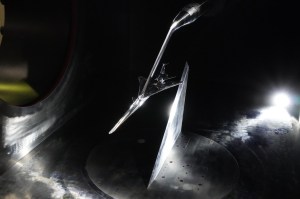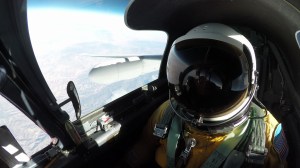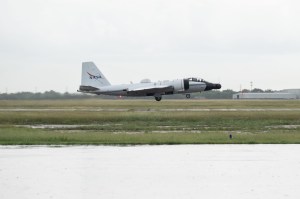This is the second of a three-part series in which NASA Aeronautics’ senior writer Jim Banke tells his newborn grandson, Axel, the story about how two recently concluded research projects will help achieve a long-held vision for the future of aviation. In part one Axel was introduced to the UAS in the NAS project. The story continues…
Wow, Axel, about a third of the way into the story about work recently done by NASA’s aeronautical innovators and you’re still wide awake and smiling at me. I take this as a good sign you’re enjoying the story and love airplanes as much as I do.
To fully appreciate this part of the story, it would be helpful here to tell you about the two key technical areas that were an important part of the research in the Unmanned Aircraft Systems in the National Airspace System (UAS in the NAS) and the UAS Traffic Management (UTM) projects.
First up is Detect and Avoid, or DAA. This has to do with an aircraft’s ability to sense when it is about to find itself dangerously close to another object (detect), and then do something appropriate to make things safe (avoid).
As an example, this might mean an onboard radar sees another airplane, determines the two aircraft are about to fly too close to each other, or even collide, and then sounds an alert to signal the remote pilot to change course or respond in some way.
The second technical area is Command and Control, or C2. This has to do with making sure the remote pilot always has a secure and solid radio link with the aircraft. It’s that link that allows the pilot to send commands to maintain control of, and receive data back, from the drone.
“Secure and solid” in this case meant proving an aircraft’s radios couldn’t be jammed by bad guys or an accident – or that weather or topography wouldn’t affect the quality of the radio signal, and enough of the best frequencies were available to use.
Again, it wasn’t NASA’s job to invent the hardware that could do all these things. But it was our job to help put this hardware through the wringer and use the resulting information to come up with a proposed set of Minimum Operational Performance Standards (MOPS) mentioned in the first part of the story.
Phased Approach
Ultimately the UAS in the NAS project completed its work in two phases.
Phase 1 began in 2011 and primarily looked at drones operating at altitudes of 18,000 feet and higher. Airplanes at this height are in constant contact with air traffic controllers, must file flight plans, and follow long-established rules when in this airspace.
Phase 2 began in 2016 and considered drone operations in the altitude range of 500 feet to 10,000 feet high. Airplanes in this airspace are more likely to be General Aviation aircraft, many of which don’t need to file flight plans or interact with air traffic control.
Remember Mauricio Rivas, my friend who managed the UAS in the NAS project?
He told me this made writing a MOPS for this airspace a bit more challenging. With more aircraft of so many different types flying in this airspace without someone always directing the traffic, the MOPS had more scenarios to account for to avoid potential trouble.
Just like every college course ends with a final exam – something, Axel, I expect you will experience in about 18 years or so – each of these UAS in the NAS phases ended with a big test.
For Phase 1 the final test happened in June of 2018 and resulted in making aviation history.
The whole point of the UAS in the NAS project was to enable these larger, remotely piloted drones to make a flight just like any other piloted airplane flying in commercial airspace. The final test for Phase 1 saw that very thing happen.
What was unique and history making was the fact that the drone – NASA’s Ikhana UAS in this case – made the flight without a piloted aircraft flying nearby to keep an eye on it. All previous flight tests were required by FAA rules to have this “chase” plane.
Granted a waiver by the FAA under the condition the flight be made following all the standards developed during the Phase 1 flight tests, Ikhana took off without a chase plane from Edwards Air Force Base in California.
It flew in commercial airspace to other points within the state and then returned to Edwards. During the flight, air traffic controllers talked to the remote pilot as though the pilot was on the airplane.
The controllers later said the flight sounded and looked on their displays like any other flight.
And since that was the whole point – success!
“They didn’t have any idea the pilot was on the ground. This was a really significant achievement, not just because it was a cool thing to do, but it was historic. The fact that the controllers didn’t know it was unmanned, that was just icing on the cake.”
That’s what Lee Noble said to me about the flight. He’s director of the Integrated Aviation Systems Program, which is the program that oversaw the UAS in the NAS project.
The finals for Phase 2 weren’t historic to the same extent, but Lee said they were just as significant.
For this final part of the project, which took place in 2020, two companies partnered with NASA to participate in what was called a Systems Integration and Operationalization Demonstration Activity, or SIO. A mouthful, Axel, I know, but easy to understand.
The basic idea was for each company to take all they had learned so far about DAA and C2 and demonstrate the ability to fly its drone on a specific mission that would be an example of a possible future use for a commercial UAS flight within the NAS.
The first SIO flight was in April 2020. General Atomic Aeronautical Systems flew its SkyGuardian UAS over southern California on an infrastructure inspection mission from 10,000 feet high.
The second SIO flight was in September 2020, less than two weeks after you were born. Bell Textron flew its APT 70 UAS near Fort Worth, Texas on a simulated urgent medical transport mission.
In both cases the remote pilots had to interact with air traffic controllers as they navigated flying through busy airspace. And in both cases these final exams of Phase 2 were given passing marks.
Here’s how Lee explained the importance of the SIO’s:
“Beyond the SIO flights themselves, the idea was to coordinate with our partners and the FAA as they worked through the process that would lead to certifying these systems. The partners learned some things about what was important to the FAA, and the FAA learned some things about how the partners viewed the process and what they struggled with along the way.”
Incidentally, a third company, American Aerospace Technologies, was planning to conduct a third SIO before the UAS in the NAS project officially ended last year, but various issues delayed it into 2021.
Like the first two SIO demonstrations, the third one was a success too.
So that was the UAS in the NAS project: Making it possible for remotely piloted medium to big drones to safely fly among other airplanes in airspace from 500 feet up all the way to the top of the flyable atmosphere – and all while staying in touch with air traffic managers everywhere.
Mauricio wrapped it all up this way:
“Of course, this will all change as technology improves, applications change, and we gain more experience. But getting that initial set of standards to the FAA so others can come along and use them to fly for these commercial purposes… This is going to open up new industries for the country.”
But what about small drones flying closer to the ground, below the altitudes covered by the UAS in the NAS project? It took a “crazy” idea revealed in a 2013 YouTube video to get at least one NASA engineer thinking about it.
And his idea might change aviation forever.
To be concluded on Wednesday, May 5…
In the final part of this three-part story told to his grandson, Axel, Grandpa Banke describes the goals and accomplishments of the UTM project and how both the UAS in the NAS and UTM projects will influence NASA’s Advanced Air Mobility mission now and well into the future.







































